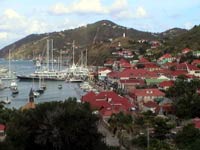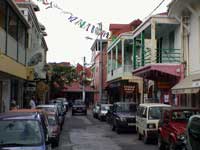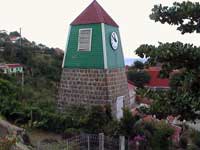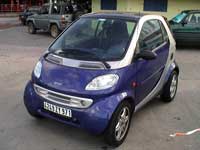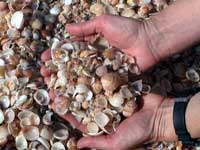
The Nantucket Clipper is anchored at St. Barthélemy ("San Bar-tailer-mee") next to the capital city of Gustavia. During the American Revolution, American rebels bought arms and supplies from this French island. After the American revolutionary war, in 1784, the King of France traded the island to Sweden. No one living on St. Barts at the time knew they were not French anymore. One day someone arrived by ship and surprised them with the news! The King of Sweden made St. Barts a neutral, free port where people from any country could buy and sell things. Statia was a nearby free port, but Statia had made the British angry. England destroyed the Statian shops and took most of the island’s money and goods. (See December 26, 2000 journal.) After St. Barts became a free port, it received most of the business from Statia and became one of the big trading centers of the Caribbean. In the early 1800s, European countries stopped fighting over the Caribbean islands, so people could trade with anyone they wanted. After that, St. Barts was no longer a big trading center and the island citizens voted to be French again. The new King of Sweden then gave St. Barts back to France. Although St. Barts is French once again, we found a few Swedish street names here. The capital city is named Gustavia, after the former King of Sweden, King Gustav. But most Swedish buildings were destroyed in 1850 by a hurricane and fire. Now the buildings are all French. The only Swedish thing that remains in Gustav is a triangular-roofed church clock tower, known as a Swedish belfry. We found the old clock tower on a hill as we explored the outskirts of town. Today St. Barts is still good place to buy things – just as it was two hundred years ago. Lots of shops can be found in Gustavia and St. Barts is still duty-free. (Duty-free means you don’t have to pay taxes on anything you buy.) As we explored St. Barts, some of our young shipmates from the Nantucket Clipper – Bethany, Matthew and Frederick – told us they liked all the cool stores here. Frederick thought the cars here were cool, too. We saw some tiny, funny-looking cars that you can’t find back home. Unlike Saba, Statia, and St. Kitts, St. Barts is not volcanic. On those islands, the beach sand is coarse and black from the volcanic ash and lava. But St. Barts is made from ancient coral reefs. All the beaches here have white coral sand. We discovered a beach near Gustavia called Shell Beach. Thousands of seashells have washed up on the beach, which is covered entirely with shells. |
Fancy yachts fill the harbor in Gustavia, the capital of St. Barts. Gustavia is named after King Gustav, a former ruler of Sweden.
Like 200 years ago, today Gustavia has shops where you can buy all kinds of things from all over the world. St. Barts is a still a duty-free port.
On a hill above Gustavia is the only thing we found that remains from this Swedish town – the old clock tower from a Swedish church. This clock still keeps accurate time. Chimes on the hour can be heard all around the town.
Fredrick thought this was a cool car. Called the "Smart Car," it’s made in Europe by the Swatch Watch and Mercedes-Benz. This tiny car only holds two people and runs on a tiny engine that doesn’t make much pollution. Sorry, but you can’t buy these cars in the United States!
Karen holds two handfuls of seashells on the beach at Shell Beach, near Gustavia, St. Barts. |
|||||||||||||||||||||
|
||||||
